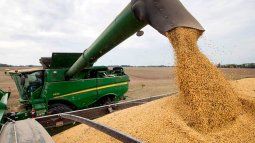The milling sector works with an idle capacity greater than 70%. The production cut hits the economy hard.
He drought impact in the real economy it will continue to be seen in the medium term. It is that so far the soybean harvest would be around 23 million tons, which represents 20 million less than last year. Within this framework and from the lack of raw material, Argentina will lose its place as the world’s leading exporter of soybean meal to Brazil. Forward, after the harvest, The milling factories propose to temporarily stop the activity taking into account that not even the soybean dollar has managed to accelerate sales by the producers for the moment.
The content you want to access is exclusive to subscribers.
Specifically, the industry, which currently has an idle capacity of around 74%, plans to import, mainly from Paraguay and to a lesser extent from Brazil, a total of 10 million tons of soybeans. In any case, there will continue to be a lack of grain and the grain that will be obtained in the local market will be of lower quality. The drought not only generated production cuts but also loss of quality of the raw material, something essential for the operation of the plant and the standards of international buyers. That is why companies are considering the possibility of bringing staff vacations in advance and putting a stop to activity for a limited period of time.


In the sector they speculated that during this week there would be a “flurry” of soybean sales, but the truth is that the reality was far from that. Since Wednesday of last weekwithin the framework of the new edition of the soybean dollar, farmers sold just over 890,000 tons of e around US$997.5 million entered the local exchange market. The worst day was this Wednesday when there were no operations.
As they explain in the market, the current prices offered by the export sector and those that the producer intends to receive are quite far from the harmony. Farmers were looking to get more than $110,000 per ton, while agro-export companies were only offering around $95,000. To this issue we must add that there is inevitably less merchandise available due to the drought, but also because the grain from the past harvest is in the hands of large agricultural producers or companies that had the financial back to maintain it.
Soybeans are the currency of exchange that governs the countryside, especially in a context of strong volatility in the markets and especially in the dollar. The rents are fixed in quintals of soybeans, the unit of measurement of the yield of the harvest, the inputs closely follow the price of the dollar and the production of the oilseed. That is why those who have grain sell what is fair and necessary in times of exchange turbulence.
On the opposite sidewalk, the small and medium producers were perhaps the most affected by the drought and as their harvest comes in they will evaluate the steps to follow. In addition, with less merchandise they move with lead foot in a market that has not yet reacted strongly to the new edition of the soybean dollar.
The projection of the Government indicates that within the program around 10 million tons would be sold and US$5,000 million would enter until next May 24. There are still five weeks to go before that period, so the market can still move more smoothly, especially considering that the combines continue to work in the fields to raise the new crop. They will be weeks of definitions for the economy and once again the countryside is the protagonist.
Source: Ambito




